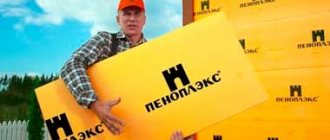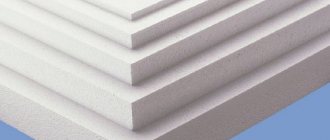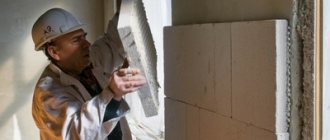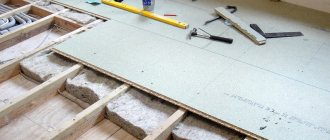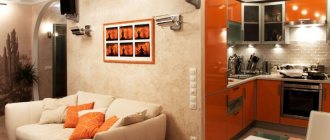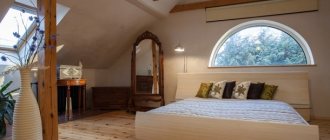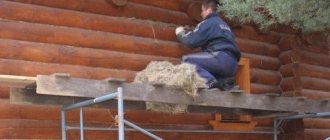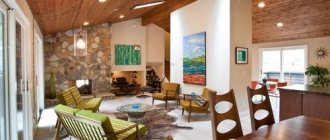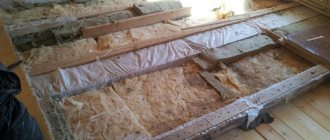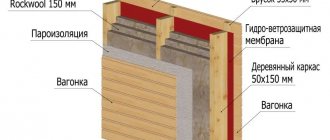Insulation from nature
Today, the Russian construction market offers a fairly wide selection of thermal insulation materials. Each of them has its own advantages and disadvantages. Interest in some materials returns more than once in new rounds of development of science and technology, sometimes at intervals of tens of years. This happens as we manage to get rid of the shortcomings of materials. These include insulation materials made from natural materials - wood, flax, jute, reeds, straw, etc.
Inter-crown insulation - jute + flax
For those who are building a house made of wood, it is very important to choose the right inter-crown insulation. In previous years, builders used ordinary tow, obtained from waste of hemp, flax and other bast crops. In recent years, the market has been offering new materials and technologies for this area. Now you don’t need to ruffle the tow and level it.
Inter-crown insulation is available in the form of rolls and from a variety of materials. For example, jute has found application in Russia. This tropical plant from the linden family has its drawbacks - it is more brittle than, for example, our flax and hemp, and not very elastic. Scientists managed to combine jute with flax and created materials with better properties than their constituent components - ribbon jute tow and inter-crown felt. They are available in different widths, so you can choose the right size for any home made of logs or timber.
By the way, scientists have also offered practitioners thermal insulation boards made from flax. Thanks to new technologies, such slabs are non-flammable, are an excellent soundproofing material, and their service life corresponds to the service life of buildings and structures. Linen insulation does not cause allergies, does not shrink, since it is made without the use of glue, and does not generate static electricity. The thickness of the mats reaches 100 mm.
Mineral wool
When deciding which insulation is better, many people choose this insulating material. Construction supermarkets offer users three types of this fiber insulator:
- glass wool;
- basalt wool, which includes mining waste;
- slag wool made from blast furnace melts.
This material has low thermal conductivity and is resistant to fungal growths and other biological organisms. Mineral wool is resistant to sudden temperature changes and is classified as non-flammable. It comes in the form of slabs or rolls, which are convenient to install on any surface.
Thermal insulation of the ceiling is effective, which can be done with the help of this material both from the inside and outside of the ceiling. In both options, it is necessary to install a vapor barrier at the bottom of the material, and a water barrier at the top. This will help rid the material of its main shortcomings:
- ability to absorb and accumulate moisture;
- evaporation of phenols, which may be part of the insulation.
Installation of mineral wool from the inside of the building is carried out on a pre-prepared sheathing, into the openings of which the material is installed. The frame is most often made of wood, but in some cases a galvanized profile can be used. The surface of the insulation is covered with a vapor barrier and finishing material. In the case of a bathhouse, this could be lining or other structures made of natural wood. You can learn more about the technology of insulating rooms with mineral wool by watching a step-by-step video.
The technology for installing this insulation from the attic side is the same as from the inside of the room. The only difference is the absence of lathing, since laying is done between the joists. In general, mineral wool can be laid on any surface, both in a frame bath and in a permanent brick structure.
When deciding how to insulate the walls in a bathhouse, you will definitely encounter the problem of choosing insulation. When purchasing a heat insulator, it is necessary to take into account its technical characteristics and standard sizes, environmental friendliness and fire safety.
Types of thermal insulation materials:
- Mineral (basalt) wool. The most popular version of the insulator, which promotes the best heat retention in the bathhouse. The new generation of mineral wool insulation is produced using not formaldehyde, but chemically neutral acrylic that does not emit toxic substances when heated.
- Peat blocks filled with sawdust and straw. They are characterized by bacterial static, non-flammability, and hygroscopicity.
- Foam glass. Environmentally friendly insulation that perfectly retains its performance properties over time, but is heavy in weight and expensive.
- Cork mats. They do not absorb moisture, do not deform, and retain heat well.
- Polyurethane foam boards. With aluminum coating on both sides. Used for insulation of Finnish baths.
- Expanded polystyrene, foam plastic. It is used as an insulator for insulating bathhouse walls from the outside, but not from the inside, because its destruction occurs at +60 degrees, and carcinogens are released.
- Natural insulation. Felt, wool, reeds, sawdust, moss, flax, straw, hemp - materials that have been used for insulation of Russian baths from time immemorial. It is not recommended to use it without special treatment to avoid rotting and damage by rodents.
The reeds rustled
In recent years, scientists have been very closely studying the properties of reeds. It would seem that it catches fire easily, is short-lived, and in the eyes of the uninitiated cannot in any way be considered a good wall material, much less an insulation material. However, the research results are surprising: reed, when it is tightly compressed, is very difficult to set on fire, due to the high silicon content it is not susceptible to getting wet and rotting, the reed stem has tensile strength several times higher than that of oak, reed slabs are excellent protection against noise Moreover, reed is a lightweight, cheap, renewable material. From 1 hectare you can collect up to 18 tons of reeds.
As a result, today in many countries of the world reed is used more and more widely. Plates made from this plant are used as thermal insulation materials in the construction of both external walls and internal partitions, especially in attic floors. In the form of sheaves, reeds serve as an excellent roofing material that does not allow water to pass through, is not flammable, is easily ventilated and decorates the appearance of the house. Gazebos, fences and other objects are also built from reeds.
"Sandwich" made of wood
Back in the middle of the last century, the USSR began producing heat-insulating wood fiber boards (TDVP) in the form of mats up to 120 mm thick. Unlike chipboard (chipboard) and fibreboard (fibreboard), these boards were similar in structure and color to glass wool and mineral wool, were just as soft, loose, and could not be hammered with nails. They had the advantages inherent in wood; first of all, they were environmentally friendly. Slabs were obtained from waste wood.
According to Vadim Maltsev, academician of the Russian Academy of Natural Sciences, Doctor of Chemistry. n., one of the country's leading specialists in studying the properties of wood, the waste was turned into chips, then de-fibered, that is, crushed in special installations - defibrators, then pressed at a temperature of about 80? C. It was assumed that during this process a resinous fraction should be released from the wood pulp, which would hold the slab together. In fact, the slabs turned out to be not very resistant, not protected from mold and fire. They could have caught fire during the manufacturing process in the oven. And the production of such slabs was practically stopped by the end of the last century.
But in the early 2000s, similar slabs began to arrive on the Russian market from abroad, primarily from Germany. Some Russian entrepreneurs purchased equipment and launched the production of new generation insulating fiberboards. German technology differs from domestic technology. With this technology, wood layers alternate with layers of polyester non-woven materials. This “sandwich” allows you to obtain a slab of almost any thickness - as a rule, it ranges from 30 to 200 mm - and of fairly high quality. This board is denser, holds its shape well, breathes, and is impregnated during the manufacturing process with compounds that protect it from rotting, mold, and mildew, increasing its fire resistance.
Says Semyon Goglev (photo on the left), deputy chairman of the board of the NP “Association of Wooden House Construction”:
Where can I get raw materials for manufacturing?
Raw materials for such mats are not so difficult to find. Especially if there is a pond, lake or river somewhere nearby. Due to their spongy stem structure, reed mats are very soft and warm. The collection of reeds for mats for construction purposes is done around September-October. The most important and important thing about reed mats is that they are made without the use of artificial and synthetic additives. To ensure a beautiful looking reed mat, you need to carefully select high-quality reeds.
Since reed mats are environmentally friendly, have a beautiful appearance, are long-lasting and do not absorb moisture, they can be used for construction purposes, furnishing homes and adding beauty to the design of a room or yard. Also, reed mats are perfect for creating gazebos, bar counters and display cases.
Insulation with reed mats
High-quality insulation of housing, in addition to comfort and coziness, also leads to significant savings in the family budget. Thermal insulation measures taken save up to 50% of heating costs during the cold season.
Reed slabs, or mats, are used for thermal insulation of both external and internal walls of a building.
Scheme of thermal insulation of external walls with reed slabs.
A wall reinforced on both sides with reed slabs and treated with plaster on top of them has an energy-saving effect comparable to brickwork 2 bricks thick. Walls can be insulated with reeds using ready-made modules produced on an industrial scale. The raw materials are harvested in the autumn-winter period and pressed into mats, secured with galvanized wire or propylene fishing line for strength. For this purpose, annual stems of a certain diameter from 7-15 mm are selected. The thickness of the product varies from 2 to 5 cm, and the size can be different and depends on the technology used by the manufacturer. Products in which the density of stems reaches 100-110 pieces per 1 linear meter of area are considered to be of high quality. Such mats are used for external thermal insulation, and in reed slabs for internal insulation, a lower density of 60 reeds is acceptable. The small thickness is provided specifically for the possibility of plastering work on top of the insulation layer.
The products can be produced in rolls, and those who wish to form the coating themselves can purchase reed raw materials in Eurosheaves to avoid difficulties in preparing and storing the material. In such packages, the products are already cleared of leaves and impurities, the stems are selected straight and of the same size. Any types of reed products from the manufacturer undergo special antiseptic treatment before going on sale.
Methods for insulating the ceiling from the outside
Let's look at how to insulate a wooden ceiling coated with clay. You should know that after completion of the work it will be very difficult to redo the thermal insulation, so it is better to observe technological details.
First prepare the base:
- Clean the ceiling from the old coating. Remove not only the dilapidated layers of insulation, but also remove sharp parts and elements so as not to damage the waterproofing film.
- Clay insulation is performed from the attic side. The composition must be laid on the load-bearing floor beams. The clay is leveled to the level of the top edge of the beams.
- If the mixture is laid out on the flooring (floor), first, logs are installed that will divide the surface into separate cells. The height of the log beam must be equal to the height of the future insulation layer (at least 30 cm).
- To provide thermal insulation during the construction stage, immediately nail 5x5 cm cross-section slats to the beams from below with a gap of 2 cm. Cover the slatted structure from below with a plywood shield. Apply clay insulation, let the mixture dry, remove the panels and move to another area - spread the composition over the entire area of the room. Sometimes owners use boards instead of slats, laying them without gaps. The result is a flat ceiling surface suitable for finishing cladding, but the option with boards is a little more expensive.
- Now lay sheets of thick cardboard on the subfloor and cover with thick film on top. The film is laid out with an overlap of 20 cm, the seams are fastened with tape. It is important to insulate the cardboard as much as possible since the clay will be wet.
Important! Before laying clay, the chimney should be insulated. Hot areas should not come into contact with clay insulation - this will lead to cracking and deformation of the entire layer.
And don’t forget about electrical wires and communications - the elements are protected by corrugated pipes and laid out in the right order.
We carefully look for shortcomings
Ideal insulation is just a utopia. Each individual case has its own disadvantages, and Kamka is no exception. There are quite a few disadvantages to this product:
- Poor efficiency. This material belongs to the insulation materials of medium thermal conductivity. This means that to create reliable protection from the cold, you will have to create a very thick layer. Kamka is 2 times less effective than polystyrene foam. In comparison with more modern materials (penoplex, basalt wool, etc.), the difference is even more noticeable. Therefore, such technologies are practically not used in cold countries.
Advice: for the southern regions such thermal insulation will be quite sufficient.
- Weak mechanical strength. Mats of this material tear very easily, as a result of which they immediately turn into dust. Collecting this mass will be extremely difficult and not very pleasant. Therefore, installation becomes a rather difficult task.
- Relatively heavy weight. If compared with the same polystyrene foam or penoplex, then models made from algae will be significantly inferior. The impressive weight not only complicates the installation process, but also forces the construction of a fairly strong frame.
- In its original form, algae insulation is practically not subject to combustion. However, after a few years (depending on average annual temperatures), it begins to dry out and practically loses this quality.
- The need to build a moisture-proofing layer. Most modern analogues are highly resistant to moisture.
How is stem selection carried out?
As practice shows, the service life of roofing reeds depends 100% on the quality of the workpieces. When choosing a roof for your cottage, you need to select materials according to the following criteria:
- Stems with uneven coloring or cores with a spongy structure should not be used. The service life of these materials is minimal.
- Ideally, the age of reeds and reeds should not exceed 12 months, since otherwise there is a high probability of accumulation of harmful substances from the atmosphere.
- If you are interested in reed roofing for a building with complex architecture, look at photos of completed projects on our website. Since the stems are thin and flexible, reeds can be mounted on any structure - from gazebos to luxurious mansions.
- Traces of bacterial damage are unacceptable on the outer layer. If the material has been exposed to mold and fungi, it is not allowed for use.
- The diameter of the reeds should not exceed 8 millimeters and the length 2 meters.
After this, at the enterprise the material is treated with fire retardants on the outside and inside to avoid ignition during operation. Fire safety depends not only on the quality of fire retardants, but also on how the roof is laid with reeds. You can learn more from the video prepared by our team.
Areas of application of kamyshite
Reed and reed slabs are used in the construction of agricultural, residential and industrial buildings as insulation in external frame walls, partitions, floors and coverings:
It is not allowed in buildings with air humidity greater than 70% and in those building structures that can become humidified during operation.
In general, if you look at the advantages of reed insulation, it becomes clear that this material is suitable for building inexpensive and environmentally friendly houses.
Do-it-yourself installation of a reed mat
Initially, the walls are leveled with starting gypsum or a mixture of cement and lime, and additionally treated with an antibacterial primer. Next, the mats are glued using mounting adhesive, foam or sealant onto a leveled surface. After this, the connecting seams between each mat are sealed with moisture-resistant sealant.
On top of the mats it is necessary to secure a steel protective mesh with dowels or clips. Well, all that remains is to cover the surface with decorative materials.
If reed mat is used as a roofing material, then you need to buy slabs with a thickness of at least 50 cm with an angular structure. Then, even during heavy rainfall, water will not stagnate and penetrate inside the slabs. It is recommended to install them on wooden beams at an angle of no more than 30-40 degrees, and cover the joints with aluminum corners.
Also, do not forget about low tides, the water from which is discharged into the storm drain. They must be installed at each point where the mat comes into contact with chimneys, satellite antenna mounts and other devices installed on the roof and secured to supporting beams.
What are the advantages of laying a reed roof?
- This is an environmentally friendly material, so when used even at high temperatures and humidity, it will not emit harmful chemicals. This is a win-win option for allergy sufferers and families with children.
- The solution is unique in terms of design and you are guaranteed to impress your guests. To see this, look at the photos of completed projects on our website.
- Since reeds and reeds are not afraid of moisture, you are not afraid of precipitation. Snow, hail, heavy rains - all this has no effect on the material. The liquid penetrates only 2-3 cm inside, but this is not dangerous.
- Air easily penetrates through the material, so the microclimate is not disturbed. This makes this solution stand out against the background of metal tiles.
- The service life reaches 50 years even when used in the harsh climate of the Russian Federation. This is the best choice in terms of price/quality ratio.
Polyurethane foam
This material is one of the answers to the question - how can you insulate the ceiling in a bathhouse? The only limiting factor to its use is the need to use specialized equipment for its application, the rental of which can be quite expensive. Among the main advantages of this material are:
- high thermal insulation properties;
- resistance to sudden temperature changes;
- high coating strength;
- the ability to carry out work both in a log bathhouse and in frame, brick or cinder block buildings.
Single-layer and multi-layer boards
Reed mats can be single-layer or multi-layer. Single-layer ones are most often used as screens, partitions, wall or ceiling coverings. They can also be used as insulation for cellars, animal rooms or summer buildings. As the name itself suggests, they are woven in one layer, and the width is approximately 20 centimeters.
Multilayer reed mats consist of several layers of reed stems. The width of the weaving is approximately 25-30 centimeters. These reed mats are usually used to construct a canopy or roof.
Recommendations from professionals
Only fatty types of clay are suitable for forming insulation. A mixture that is too dry will crumble after drying and will not provide the required plasticity when wet. It’s easy to distinguish oily clay from dry clay: you need to squeeze the wet mixture in your fist - after unclenching, your fingers stick together a little, which means the clay is good.
Do not take the mixture from the bottom of reservoirs - there is a lot of silt there, which does not have compressive strength. The material can be checked this way: wet it, roll it into a ball and flatten it - if the clay has not changed color, but moisture appears on the surface, the mixture is good, but a change in shade indicates that there is plenty of silt here, it is better not to take such clay.
A high-quality mixture, rolled into a ball and crushed in a fist, will not fall off if you turn your palm up - the pieces will fall off slowly, leaving small fractions on your hand. And a thin rod of wet mixture wrapped around a finger will not tear - this indicates the elasticity of the raw material, which is also good when laying out insulation.
And the last piece of advice: if you squeeze a dry piece of high-quality clay, it will break into small fragments, which are crushed only under the blows of a hammer; such pieces do not crumble in your fingers.
